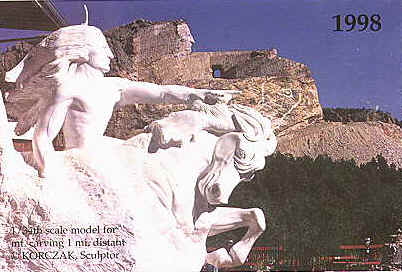|
|
 |
|
Crazy Horse
|
| Crazy Horse also known as Tashunkewitko born near Black Hills South Dakota was a visionary leader committed to preserving the traditions and values of the Lakota way of life which was recognized by his people. As a young man Crazy Horse was a legendary warrior he stole horses from the Crow Indians. When he was 5 or 6 his band got snowed in, in a severe snowstorm he went out two days later and brought back two antelopes for every one had an enough food for two days. The next day he asked his mom for food but there wasn't any left and his mom said: "Remember my son they went home singing praises in your name not my name or your fathers. You must be brave. You must live up to your reputation." Often when he was young the Sioux called him the strange one. When he was 16 he joined a party against Gros Ventres. When he was still 18-19 there was a great buffalo hunt when he got back he had 10 of them. Crazy Horses mom was a sister of Brule Chief spotted tail and his father was an Oglala medicine man who often wanted to drive out the whites. |
| He led his first war party before turning twenty. He also fought in the 1865-1868 war led by the Oglala chief Red Cloud. Crazy Horse played a key role in destroying William J. Fetterman's brigade at Fort Phil Kearny in 1867. Before that battle in 1865 he was named "Shirt Wearer" or protector of the people in recognition of his valor and his achievement. |
| In 1867 he was named supreme war and peace chief of Oglalas. In January 1876 he led Sioux and the Cheyenne to victory of the battle of Rose Bud. That July he led the same tribe warriors in the battle of Little Big Horn. He earned his reputation among leaders by his skill and daring in battle and by his fierce determination. He did not allow any pictures taken of him nor did any one except his tribe members knows where he was buried. |
| What he fought for was to prevent American encroachment on Lakota lands following the Fort Laramie Treaty of 1868 helping to attack a surveying party sent into the Black Hills By General George Custer in 1873. When the War Department ordered Lakota bands into reservation in 1876 Crazy Horse became a leader of the resistance. After victory at Little Big Horn he joined forces with Sitting Bull and on June 25 he led his band in the counter attack that destroyed Custer's 7th Calvary, flanking the Americans from North to West as Hunkpapa warriors led by chief Gall charged from South to East. |
| Afterwards Crazy Horse remained to battle General Nelson Miles As he pursued the Lakota and their allies relentlessly throughout the winter of 1876-1877. With the non-stop harassment and decline buffalo population eventually Crazy Horse surrendered. Crazy Horse surrendered on May 6, 1877. Except for Gall and Sitting Bull he was the last important chief to yield to battle. |
| Even after defeat Crazy Horse was an independent spirit. In September 1877 when he left reservation without permission to take his sick wife to her parents General George Crook ordered him arrested fearing that he was plotting a return to battle. At first he did not resist from getting arrested but when he realized he was being taken to a guard house he began to fight his arms were being held back and he tried pulling his sword then all of a sudden a soldier ran through him with a bayonet. |
| He was killed in1877 at Fort Robinson, Nebraska. One of his tribe members was said to say "He was born like Chief Joseph the only difference was Crazy Horse was born a warrior." But Crazy Horse was like a lot of men. Like Osceola he rose sudden, like Tecumseh he was impatient for battle, like Pontiac he fought on while his allies were suing for peace and justice, and like Grant he was a man of deed and not of words. He won every battle with the exceptions of a couple. These were meant to be his last words "Another white mans trick. Let me go! Let me die fighting! In Crazy Horses memories a monument of him is being carved out of a Mountain in the Black Hills in South Dakota. |
|
|
 |
| Chris Linnemann
8th Grade 2001 American History Rossville Junior High |